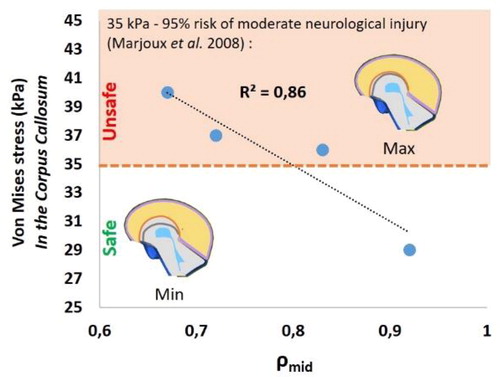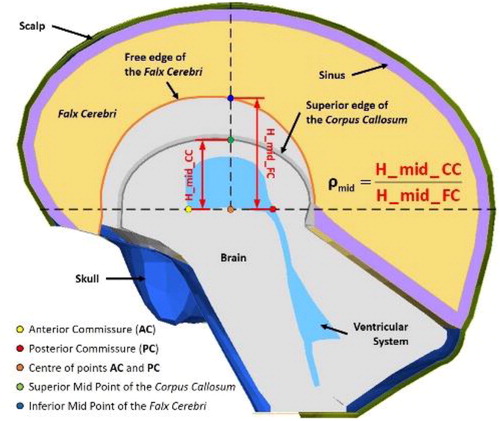1. Introduction
Concussions are a common head injury in contact sports such as rugby; nevertheless, the associated injury mechanisms are not yet fully understood. On impact, mechanical loading of the corpus callosum was shown to be strongly associated with the occurrence of concussion (Jang et al. Citation2019). In addition, a recent study based on finite element simulation of lateral impacts on the head, has demonstrated the influence of the interaction between the falx cerebri and the corpus callosum on its mechanical loading (Hernandez et al. Citation2019). However, the relationship between this local anatomy and these mechanical loads has not yet been analysed.
The aim of this study is, therefore, to evaluate the influence of the geometry of the corpus callosum (CC), relative to falx cerebri (FC), on its mechanical behaviour during a lateral impact (Hardy et al. Citation2007). This study is based on a parametrised finite element model of the human head.
2. Methods
2.1. Parametric finite element head model
A parametric modelling of the head and its main components (cranial cavity, brain, brain stem, CC, FC, tentorium cerebelli, ventricular system, main sinus and bridging veins) has been developed, based on a previously method proposed at IBHGC (Laville et al. Citation2009). The global mesh is based on 162 geometrical primitives (383 parameters) and the coordinates of 12 anatomical landmarks. Scalp, skull, FC and tentorium cerebelli were modelled using quad shell elements (ca. 2,700), whole brain volume, blood in the main sinus and the cerebrospinal fluid in the ventricular system using tetra elements (ca. 61,000). Spring elements were used to model 11 pairs of bridging veins ().
In this study, homogeneous and linear elastic material laws were used to model the mechanical behaviour of all the structures; data were extracted from the literature (example in ). The interaction between the skull and the brain was modelled using a tied interface.
Table 1. Example of material properties extracted from the literature.
2.2. Influence of the anatomy of the corpus callosum
An average Finite Element Head Model (FEHM) was constructed using the mean geometry obtained from a Principal Component Analysis, performed on a database of 40 intra cranial surfaces reconstructed from CT-scan data (AP-HP, authorization 1980120 − 9♀/31♂, mean age (± SD) = 60 ± 20.8 yo).
From this average model, four models were created by modifying the mid ratio ρmid (0.67; 0.72; 0.83; 0.92), representing the free space between the free edge of the FC and the CC (). In this study, the mid height of the FC (H_mid_FC) was fixed at 35 mm (Staquet et al. Citation2020).
The lateral impact C380-T6 from the study of Hardy et al. (Citation2007) was simulated (lateral impact of a cadaveric head on a 25 mm thick fixed acrylic plate at a speed of 3.3 m/s). Maximal values of the Von Mises stresses in the CC were recorded. The influence of the geometry of the CC was then evaluated by comparing the values obtained with the four models and using a Pearson correlation test.
3. Results and discussion
shows the maximum Von Mises stresses values measured in the CC for the four simulated models; values range from 40 to 29 kPa. The order of magnitude of the stress values obtained is consistent with those identified in the literature (Willinger et al. Citation1999; Horgan and Gilchrist Citation2003; Marjoux et al. Citation2008; Takhounts et al. Citation2008).
Figure 2. Variation of the maximal Von Mises stresses (kPa) as a function of ρmid and comparison to the injury threshold defined by Marjoux et al. (Citation2008).

Results show that the more ρmid increases, i.e., the free space between CC and FC decreases, the less the maximal Von Mises stresses are high (Pearson R2 = 0.86, p = 0.04). In other words, the Von Mises stress decreases the closer CC is to the free edge of the FC. This trend seems to contradict the conclusion of Hernandez et al. (Citation2019) who showed that the strain in the CC decreased (from 0.37 to 0.17) in simulations without taking the FC into account. Nevertheless, FC is a rigid element in the centre of the cranial cavity that limits lateral movement of the brain; without it, the CC is free to move and is then less stressed. This hypothesis could be investigated in the future by modifying both mid ratio ρmid and the mid height of the CF (H_mid_FC).
By comparing the maximum values of the Von Mises stresses in the CC obtained for the four simulations with the 95% injury risk threshold of moderate neurological injury proposed by Marjoux et al. (Citation2008) (), it appears that some anatomies may be more at risk than others.
However, these first results need to be analysed qualitatively because of the simplifying assumptions that have been made (homogeneous and isotropic materials…).
4. Conclusions
The next step will therefore be to evaluate this first model more widely in relation to the international literature before making it more complex. Interactions between all the geometric parameters will also be explored.
References
- Hardy WN, Mason MJ, Foster CD, Shah CS, Kopacz M, Yang KH, King AI, Bishop J, Bey M, Anderst W, et al. 2007. A study of the response of the human cadaver head to impact. Stapp Car Crash J. 51:17–80.
- Hernandez F, Giordano C, Goubran M, Parivash S, Grant G, Zeineh M, Camarillo D. 2019. Lateral impacts correlate with falx cerebri displacement and corpus callosum trauma in sports-related concussions. Biomech Model Mechanobiol. 18(3):631–649.
- Horgan TJ, Gilchrist MD. 2003. The creation of three-dimensional finite element models for simulating head impact biomechanics. Int J Crashworthiness. 8(4):353–366.
- Jang SH, Kim OL, Kim SH, Lee HD. 2019. Differences in corpus callosum injury between cerebral concussion and diffuse axonal injury. Medicine. 98:e17467.
- Laville A, Laporte S, Skalli W. 2009. Parametric and subject-specific finite element modelling of the lower cervical spine. Influence of geometrical parameters on the motion patterns. J Biomech. 42(10):1409–1415.
- Marjoux D, Baumgartner D, Deck C, Willinger R. 2008. Head injury prediction capability of the HIC, HIP, SIMon and ULP criteria. Accid Anal Prev. 40(3):1135–1148.
- Staquet H, Francois PM, Sandoz B, Laporte S, Decq, Goutagny S. 2020. Surface reconstruction from routine CT-scan shows large anatomical variations of falx cerebri and tentorium cerebelli. Acta Neurochir (Wien).
- Takhounts EG, Ridella SA, Hasija V, Tannous RE, Campbell JQ, Malone D, Danelson K, Stitzel J, Rowson S, Duma S. 2008. Investigation of traumatic brain injuries using the next generation of simulated injury monitor (SIMon) finite element head model. Stapp Car Crash J. 52:1–31.
- Willinger R, Kang HS, Diaw B. 1999. Three-dimensional human head finite-element model validation against two experimental impacts. Ann Biomed Eng. 27(3):403–410.

